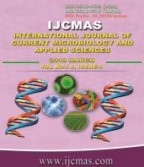


 National Academy of Agricultural Sciences (NAAS)
National Academy of Agricultural Sciences (NAAS)

|
PRINT ISSN : 2319-7692
Online ISSN : 2319-7706 Issues : 12 per year Publisher : Excellent Publishers Email : editorijcmas@gmail.com / submit@ijcmas.com Editor-in-chief: Dr.M.Prakash Index Copernicus ICV 2018: 95.39 NAAS RATING 2020: 5.38 |
Evaporative cooling system is one of the cooling techniques, but the limitation is that cooling can be done up to wet bulb temperature only, so a study has been taken up to design, develop a two-stage evaporative cooling system. Cooling performance of two-stage indirect/direct evaporative cooling system was experimentally investigated. For this purpose, a two-stage evaporative cooling experimental setup consisting of an indirect cooling stage (IDC) followed by a direct evaporative cooling stage (DEC) was designed, constructed and tested. The performance evaluation was done with respect to three different air supply velocities, three pad thicknesses and three water flow rates. The results showed that air velocity of 16.70 m/s, pad thickness of 200 mm, and water flow rate of 5 lpm were found to be the best operating parameters to obtain maximum reduction in air temperature between 22.10 to 25.80 °C. Also, average relative humidity of air leaving was found to be in the range of 40.50% to 72.83%. The obtained results were investigated for best operating parameters with a CFD code. The mathematical model, governing equations and the boundary conditions were implemented in the code and the calculated results were analyzed and compared with experimental data. The results were almost similar in both the cases and briefly described here under.
 |
 |
 |
 |
 |